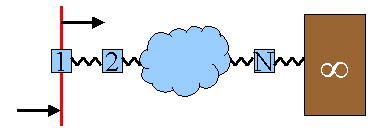Statistical Physics & Control Theory
 A vision shared by most researchers in complex systems is that certain intrinsic, perhaps even universal features capture
fundamental aspects of complexity in a manner which transcends specific domains. It is in identifying these features that
differences arise. In disciplines such as biology, engineering, sociology, economics, and ecology, individual complex systems
are necessarily the objects of study, but there often seems to be little common ground between their models, abstractions,
and methods. Highly Optimized Tolerance (HOT) is a recent attempt to develop a general framework for studying complexity,
which was introduced by Carlson and Doyle. The HOT view is motivated by examples from biology and engineering, and builds
theoretically on the abstractions from control, communications, and computing. A central component of our research program
involves extending this theoretical framework.
A vision shared by most researchers in complex systems is that certain intrinsic, perhaps even universal features capture
fundamental aspects of complexity in a manner which transcends specific domains. It is in identifying these features that
differences arise. In disciplines such as biology, engineering, sociology, economics, and ecology, individual complex systems
are necessarily the objects of study, but there often seems to be little common ground between their models, abstractions,
and methods. Highly Optimized Tolerance (HOT) is a recent attempt to develop a general framework for studying complexity,
which was introduced by Carlson and Doyle. The HOT view is motivated by examples from biology and engineering, and builds
theoretically on the abstractions from control, communications, and computing. A central component of our research program
involves extending this theoretical framework.
HOT emphasizes 1) highly structured, non-generic, self-dissimilar
internal configurations and 2) robust, yet fragile external behavior.
In HOT these features are inherent, important features of complexity,
not accidents of evolution or artifices of engineering design, but
rather inevitably intertwined and mutually reinforcing. HOT provides an
appealing base for the development of a general framework for
understanding a broad spectrum of complex systems. Questions related to
robustness, diversity, predictability, verifiability, and evolvability
arise in a wide range of disciplines, and demand sharper definitions,
and new tools for analysis. The success of HOT came from first studying
tractable, broadly accessible models, from which we extract qualitative
insights and quantitative analysis which can be applied to specific
problems.
 HOT
blends the perspectives of engineering control theory with the simple
models of statistical physics. While physics focuses primarily on
universal properties of generic ensembles of isolated systems, control
theory studies open systems in terms of their input vs. output
characteristics, and has the flexibility to describe systems which are
highly structured and extremely non-generic in a systematic way.
Currently, we are moving further in developing links between the
mathematics of control theory and fundamental problems in statistical
physics by using model reduction on finite time horizons to derive
rigorous links between statistical physics, thermodynamics, and
measurement. Model Reduction
and other mathematical methods have been developed with precision in
control theory, but their consequences outside of that discipline are
largely unexplored. Many of these methods when properly generalized
will become the building blocks for quantitative analysis of complex
systems across a broad range of disciplines.
HOT
blends the perspectives of engineering control theory with the simple
models of statistical physics. While physics focuses primarily on
universal properties of generic ensembles of isolated systems, control
theory studies open systems in terms of their input vs. output
characteristics, and has the flexibility to describe systems which are
highly structured and extremely non-generic in a systematic way.
Currently, we are moving further in developing links between the
mathematics of control theory and fundamental problems in statistical
physics by using model reduction on finite time horizons to derive
rigorous links between statistical physics, thermodynamics, and
measurement. Model Reduction
and other mathematical methods have been developed with precision in
control theory, but their consequences outside of that discipline are
largely unexplored. Many of these methods when properly generalized
will become the building blocks for quantitative analysis of complex
systems across a broad range of disciplines.
Even within statistical physics and quantum theory there are
situations where mathematics from control theory can lead to a more
rigorous theoretical foundation. This is particularly true where the
coupling between a system and the environment must be explicitly taken
into account, as in the case of dissipation and quantum measurement.
The opportunities for developing a more quantitative theoretical
foundation which extends to other disciplines is extremely promising.
In areas such as biology, ecology, sociology, and finance, systems are
necessarily open, highly structured, and involve a great deal of
feedback, so they are clear candidates for methodologies from controls.